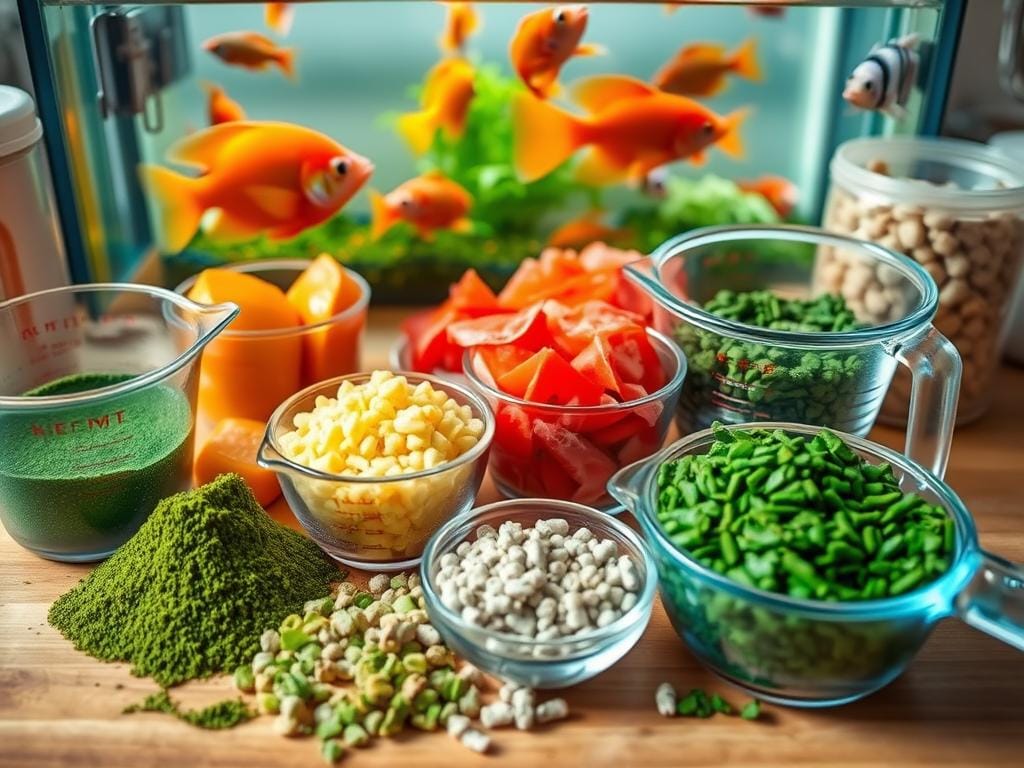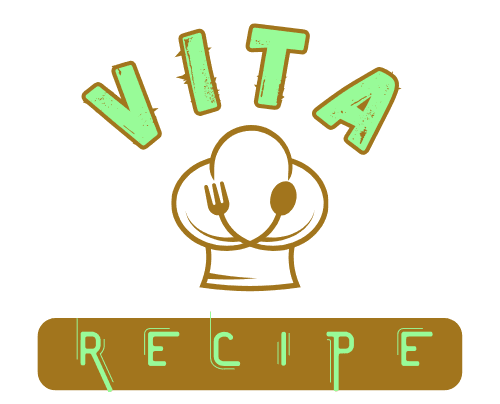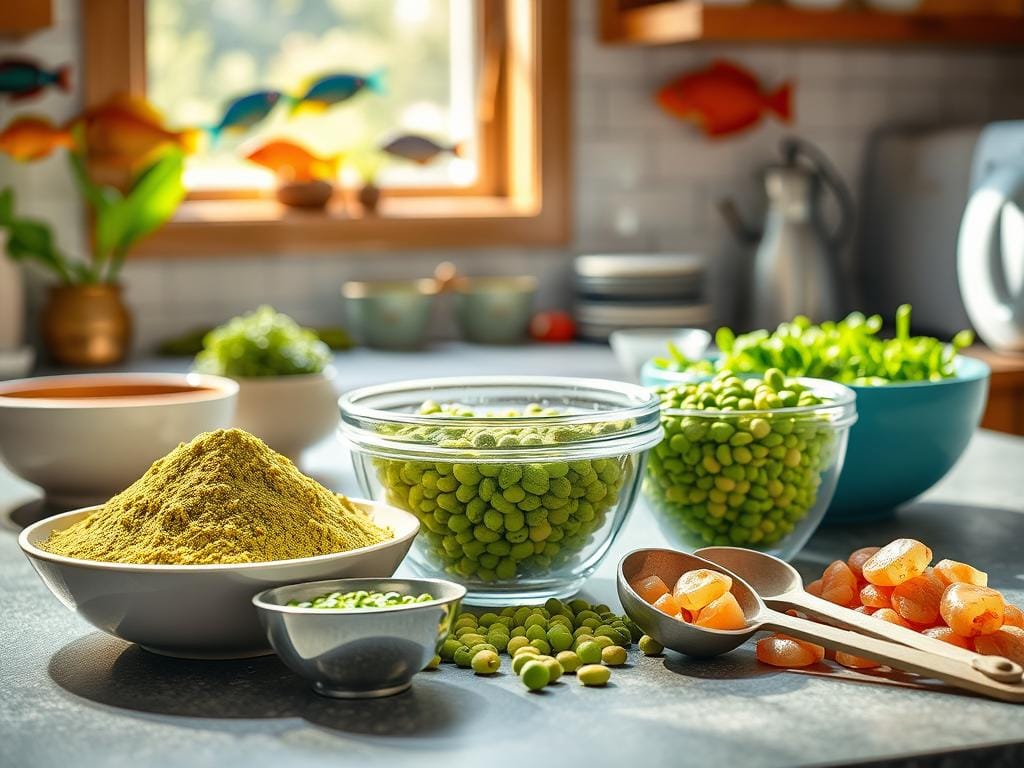As an avid aquarium enthusiast, I know how vital it is to feed your fish well. Homemade fish food is a great way to meet their dietary needs. It also saves money and ensures your fish get the best nutrients. In this guide, we’ll look at the top homemade fish food recipes that will make your fish happy!
Table of contents
- Key Takeaways:
- Understanding Fish Nutritional Needs
- Benefits of Homemade Fish Food
- Types of Homemade Fish Food
- Essential Ingredients for Your Recipes
- Simple Fish Food Recipes to Try
- Tips for Preparing Fish Food
- Feeding Guidelines for Homemade Fish Food
- Common Mistakes to Avoid
- How to Transition Fish to Homemade Diets
- Resources for Further Exploration
- FAQ
Key Takeaways:
- Homemade fish food can contain over 55% protein by dry weight, making it a highly nutritious option.
- Gel-based recipes allow for customizable ingredients like canned salmon, algae powder, and gelatin.
- Commercial gel food options like Mazuri’s Aquatic Gel Diet provide convenient alternatives.
- DIY fish food enables tailoring to specific fish species and their unique nutritional needs.
- Crafting homemade fish food can be more cost-effective, even for large aquariums.
Understanding Fish Nutritional Needs
For a thriving aquarium, understanding what fish need in their diet is essential. Proteins, fats, and vitamins all play key roles in their development and health. If you’re interested in general food recipes with balanced nutrition, check out our guide to quick and easy healthy salad recipes for weight loss.
Proteins: Building Blocks for Growth
Fish like cichlids and bettas require a diet high in protein for growth and vitality. Consider ingredients like lean fish fillets or shrimp in your homemade mix. For additional meal ideas featuring proteins, explore recipes such as easy lemon butter fish.
Fats: Energy Sources for Your Fish
Fats give fish energy and help them absorb vitamins. But, too much fat can harm their liver. This can make the water quality worse.
Vitamins and Minerals: Essential Elements
Vegetables like zucchini, spinach, and peas add much-needed vitamins to your fish’s diet. To see how vegetables play a crucial role in other recipes, view our dense bean salad recipe.
| Nutrient | Importance | Recommended Range |
|---|---|---|
| Protein | Essential for growth and development | 18-50% of dry weight |
| Lipids | Provide energy and facilitate vitamin absorption | 10-25% of dry weight |
| Carbohydrates | Serve as an energy source, mainly for omnivores and herbivores | 15-20% of dry weight |
| Vitamins and Minerals | Support various bodily functions and health | Balanced formulation |
Knowing what your fish need helps them stay healthy. A good diet includes proteins, fats, and vitamins and minerals. This keeps your fish happy and healthy.
Benefits of Homemade Fish Food
Making your own homemade fish feed has many benefits. It’s cheaper than buying it from stores. You can pick the ingredients without additives, saving money.
Homemade aquaculture feed also means fresher, better ingredients for your fish. This can make them healthier, with brighter colors and stronger immune systems. Plus, you can make recipes just for your fish’s needs.
Cost-Effectiveness Compared to Store-Bought
Homemade fish food is very cost-effective, great for big or varied aquariums. You save money by choosing your ingredients and avoiding commercial prices.
Fresh Ingredients Enhance Fish Health
Homemade recipes let you use the best ingredients. This means your fish get a diet full of nutrients. They’ll likely be healthier, with better colors and energy.
Customization for Specific Fish Species
Homemade fish food is great because you can make it fit your fish’s needs. Whether they eat plants, meat, or both, you can adjust the food to keep them healthy and happy.
Types of Homemade Fish Food
Homemade fish food can be a great choice for your fish’s diet. You can try gel-based recipes, dry pellets, or frozen food. Each option offers a unique way to feed your fish.
Gel-Based Recipes
Gel-based fish food is loved by many aquarium fans. It’s packed with nutrients and easy to make. The gel-like texture makes it easy to handle and mess-free.
Dry Pellet Alternatives
For those who prefer long-lasting options, dry pellets made from dehydrated vegetables and proteins are excellent. Pair this method with tips from our easy slow-cooker cabbage recipe for sustainable preparation.
Frozen Fish Food Options
Frozen food made from shrimp, fish fillets, or brine shrimp is a high-protein option that can be stored for months. If you’re interested in seafood recipes, consider exploring delicious grilled dorado fish recipes.

Exploring homemade fish food options ensures your fish get a balanced diet. With quality ingredients and a bit of creativity, you can boost your fish’s health and happiness.
Essential Ingredients for Your Recipes
Making tasty homemade fish food means picking the best ingredients. You can make gel, dry pellets, or frozen treats. It’s important to use high-quality, nutrient-rich items to give your fish a balanced aquarium fish diet and good fish nutrition.
High-Quality Fish Protein Sources
Proteins are vital for your fish’s growth. Use lean, high-protein foods like canned salmon, shrimp, or lean meats. These will help keep your fish healthy and growing well.
Vegetables: An Important Component
Fish also need veggies to stay healthy. Add zucchini, summer squash, and green beans to your recipes. They provide vitamins, minerals, and fiber, making your fish’s diet complete.
Fish Oils and Supplements
For young fish or certain species, add fish oils or cod liver oil. These fats help with growth. Powdered algae like spirulina or chlorella is also good. But, don’t use garlic as it’s not good for most fish.
Simple Fish Food Recipes to Try
Looking to make your own fish food at home? There are many simple recipes to try. You can make homemade fish flakes or nutritious gelatin-based foods. These DIY options are healthy and can save you money compared to store-bought feeds.
Easy Homemade Fish Flakes
To make fish flakes, blend canned salmon or tuna with powdered algae and gelatin. Spread the mix thinly on a baking sheet. Dehydrate it until it’s crisp. This makes a tasty, easy-to-store fish food that your fish will enjoy.
Nutritious Fish Gelatin Food
For a more filling homemade food, try gelatin-based recipes. Mix 16 oz of protein like canned salmon with 2 oz of powdered algae and 1.5 oz of gelatin. Blend, then add hot water with gelatin. Pour into molds or trays to set.
Balanced Vegetable Mixture
- Zucchini
- Summer squash
- Green beans
Remember to add chopped vegetables to your fish food. Mix them with your protein source for a balanced meal. Your fish will find it delicious.
| Recipe | Calories | Protein | Fat | Carbs | Sodium |
|---|---|---|---|---|---|
| Easy Lemon Butter Fish | 302 kcal | 25.7g | 19.8g | 9.9g | 158.1mg |
| Orange Soy Salmon with Rice | 437 kcal | N/A | N/A | N/A | N/A |
| Tilapia Florentine | 249 kcal | N/A | N/A | N/A | N/A |
Tips for Preparing Fish Food
Making homemade fish food is all about keeping it safe and nutritious. You need to store it right, prevent contamination, and make sure the ingredients work well together. By following these tips, you can give your fish a tasty and healthy meal.
Proper Storage Techniques
For gel-based homemade fish food, store it in thin slabs in airtight zip-lock bags in the freezer. This makes it easy to portion and thaw. Dry pellet alternatives should be kept in sealed containers in a cool, dry place. Before freezing, chop frozen fish or shrimp into bite-sized pieces for easier feeding.
Avoiding Contaminants and Spoilage
- Use clean utensils and work surfaces to prevent cross-contamination.
- Thoroughly wash all ingredients to eliminate any pollutants.
- Refrigerate or freeze perishable parts quickly to stop spoilage.
Ensuring Ingredient Compatibility
Learn what your fish needs to eat by researching their nutritional needs. Some fish need more protein, while others do better with plants. It’s key to mix the right amounts of proteins, fats, vitamins, and minerals for their health.
With these tips, you can make homemade aquaculture feed that meets your fish’s needs. This will help keep them healthy and full of energy.

Feeding Guidelines for Homemade Fish Food
Feeding your fish homemade food is key to their health. It’s important to control portions and know when to feed. This prevents overfeeding, which can harm water quality and your fish’s health.
Portion Control for Optimal Health
When giving gel-based homemade food, break it into small pieces. Spread them out evenly in the tank. This way, all fish get a fair share without any eating too much. Feed just enough for them to eat in a few minutes.
Frequency of Feeding for Different Fish
Feeding times vary by fish type. Carnivorous fish, like cichlids, need 45-50% protein and eat 2-3 times a day. Herbivorous fish, with less protein needs, eat once or twice a day.
It’s vital to know the specific needs of your fish. This ensures they get the right aquarium fish diet and fish nutrition.
Monitoring Fish Health After Changes
Watch your fish closely when you change their food. Look for changes in appetite, color, or health. If you see any issues, adjust their diet and nutrition. This keeps your fish healthy and happy.
| Fish Type | Protein Requirements | Feeding Frequency |
|---|---|---|
| Carnivorous Fish | 45-50% Protein | 2-3 Times Per Day |
| Herbivorous Fish | Comparatively Less Protein | 1-2 Times Per Day |
Common Mistakes to Avoid
Making homemade fish food is rewarding, but watch out for common mistakes. These can harm your fish’s health and happiness. Stay alert to avoid these errors.
Overfeeding: Symptoms and Solutions
Overfeeding is a big problem with homemade fish food. It can make the water dirty by adding too much waste. Look for signs like slow fish, less eating, and cloudy water.
To fix it, feed only what your fish eat in a few minutes. This keeps the water clean and your fish healthy.
Ingredient Imbalances: What to Watch For
It’s key to balance proteins, fats, vitamins, and minerals in your fish food. Too much or too little can harm your fish. Make sure your recipes have the right mix.
Check reliable sources for advice on creating a balanced diet. This ensures your fish get what they need to stay healthy.
Ignoring Fish Preferences: Importance of Variety
Fish, like people, have their own food likes. Some like soft food, others crunchy pellets. Offer different homemade foods to meet their tastes.
Watch how your fish eat and adjust your recipes. This way, you can make sure they enjoy their meals.
Avoiding these mistakes helps you give your fish a tasty, healthy diet. A balanced diet and knowing their preferences are key. This way, your fish will thrive.
How to Transition Fish to Homemade Diets
Switching your fish to homemade food requires gradual introduction. Start by mixing small portions of homemade feed with their regular food. For ideas on blending traditional methods with fresh options, check out our homemade beef breakfast sausage recipe.
Steps for Gradual Introduction
- Mix a small amount of homemade feed with their current food. Gradually add more homemade feed over a few weeks.
- Watch your fish closely as they get used to the new food. Look for signs they’re eating well and staying healthy.
- Be patient and keep trying. Some fish may need more time to get used to the new diet.
Signs Your Fish Are Adjusting Well
- Eager Feeding: If your fish eat the homemade feed eagerly, it’s a good sign they like it.
- Maintained Energy Levels: Fish that are doing well should stay active and full of energy.
- Healthy Appearance: Look for clear eyes, shiny scales, and vibrant colors. These signs mean they’re thriving on the new diet.
Alternative Options if Fish Refuse Food
If your fish won’t eat the homemade feed, don’t worry. Try different recipes or ways of preparing the food. You might also consider adding live food or brine shrimp hatcheries to their diet.
Resources for Further Exploration
Starting your journey to make homemade fish food opens up a world of resources. You can find help from university aquaculture departments, online forums, and local fish clubs. These places offer a wealth of knowledge and a chance to meet others who share your interest.
Recommended Books and Websites
Begin by looking at books and websites that focus on fish nutrition and making homemade feed. Look for information from experts in aquaculture, veterinarians, and seasoned fish keepers. Websites from universities, fish forums, and top blogs can give you insights into fish diets and tips for making healthy meals.
Online Communities and Forums
Joining online communities and forums can be a big help. You’ll meet people who make homemade fish food and are happy to share their knowledge. These places are great for swapping ideas, working on new recipes, and keeping up with the latest in fish nutrition.
Local Fish Clubs and Workshops
Look for local fish clubs or aquarium societies in your area. They often have workshops and events on fish care, including homemade food. These events let you learn from experts, ask questions, and even try making food yourself. You might also meet veterinarians or aquaculture experts who can give you personalized advice.
FAQ
Here’s a concise response to these questions:
What is the best food for fish at home?
The best food for fish at home depends on the type of fish. Common options include:
- Tropical Fish: Flake or pellet food with high protein.
- Herbivorous Fish: Blanched vegetables like spinach, peas, or zucchini.
- Carnivorous Fish: Frozen or live food such as brine shrimp, daphnia, or bloodworms. For all fish, ensure the food is nutrient-balanced and appropriate for their species.
How do I make my own fish food?
To make fish food at home:
- Gather Ingredients: Combine protein sources (fish fillets, shrimp, or eggs) with vegetables (spinach, peas, or carrots).
- Blend Ingredients: Blend everything into a fine paste with water.
- Add Binding Agent: Mix in unflavored gelatin or agar for binding.
- Shape and Store: Form small pellets or flakes, then freeze or dry them for storage.
What is the best homemade fish food for ponds?
For pond fish like koi or goldfish:
- Ingredients: Combine wheat germ, shrimp meal, and spirulina powder for protein and vitamins.
- Add Vegetables: Include finely chopped lettuce, carrots, or algae.
- Preparation: Form the mixture into small cakes or pellets. Dry or freeze them for longer shelf life. Homemade food should be high in protein during growth periods and rich in carbs during colder months.
How to make fish feed at home?
- Proteins: Use ingredients like fish meal, shrimp, or eggs for high protein content.
- Carbs: Add cooked rice, wheat flour, or cornmeal as a carbohydrate source.
- Vitamins and Minerals: Incorporate leafy greens, algae, or spirulina.
- Mix and Cook: Blend the ingredients, boil the mixture to bind it, and shape it into pellets.
- Dry or Freeze: Preserve the feed for future use.
For optimal results, adjust the recipe to suit the dietary needs of your specific fish species.

